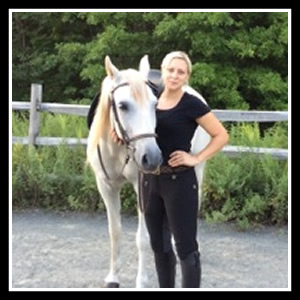Dr. Robson – Back Stretches

We are going to use Montana and Montana’s owners to demonstrate how to do a hip tuck, which is a really good exercise for two reasons.
One is to assess if the patient has a sore back: we are going to trigger a reflex point on her topline and if she resists, swings away, moves into us or acts like it’s uncomfortable that helps us determine that maybe she still has a sore back or croup. What we are actually looking for is a contraction of the abdominal muscles or her core muscles. If she is able to do the tuck, that tells me as she lifts up that she is engaging her core and is able to lift and round and come beneath with her hind end which we can do statically from the ground. This is also of course the goal for what we want to have when she is under saddle. If her owners get used to doing this exercise from the ground it also helps them picture and develop that idea in their mind of what they want to attain with her when they are under saddle.
This is an exercise that clients can certainly learn how to do for their horses. We generally start a hands width off from the highest point of the rump and when we trigger these points you will see that her pelvis actually rotates forward a little bit there. As her owner continues that stretch back you will see that she tucks her hips and contracts at her abdominal line. As her owner performs this exercise again, she lifts and rounds her back.
From a safety standpoint, people are going to watch this clip and think that “Oh my gosh this is so dangerous to stand behind the horse”. Yes it can be if the horse is in pain, you want to make sure you are not standing in the range of being kicked in the knee caps or have a horse that swings into you because they are in pain. One of the ways that you can do the exercise is to simply stand off to the side of the horse if they are short enough and you can reach up and over the top. Safety when you are standing behind the rear end of the horse is you are a lot safer standing in close rather than far behind.
That was an exercise that was very well done, thank you!
3 responses to “Dr. Robson – Back Stretches”
Leave a Reply
What are the parameters for this exercise. How many times should it be done in one session. How often should it be done? What are the benefits? If this is done regularly, will it help the horse develop the correct muscles so they are better able to use their backs under saddle? How long would it take to show improvement?
Thanks
Thank you very much for your reply Karen. I appreciate your guidance. I’ve tried the stretch a couple of times on different days and I could tell that it was not easy for him, so I backed off. I’ll do some more work on the lunge line first before I try this again. Slow and easy wins the race.
Thanks again.
Victoria





What are the parameters for this exercise. How many times should it be done in one session. How often should it be done? What are the benefits? If this is done regularly, will it help the horse develop the correct muscles so they are better able to use their backs under saddle? How long would it take to show improvement?
Thanks
Hi Victoria,
Generally we will ask for the horse to perform the back stretches no more than three times in a session and can be done daily. Of course you must always consider the horse’s response when you ask for the stretches. If it is hard for them it will be obvious so don’t overdue it but should be able to increase your expectations as the horse strengthens. The benefits are as you stated – helps the horse to connect to and strengthen/supple the muscles that you would like the horse to use when under saddle. How long it will take to see improvement is hard to tell, there are other variables to consider. If you aren’t getting the horse connected over the topline when you ride then it will take longer. If you are getting a great connection/engagement it may not be necessary to do them at all but it is always beneficial. Thanks for your interest in doing what you can to help your horse!! Karen
Thank you very much for your reply Karen. I appreciate your guidance. I’ve tried the stretch a couple of times on different days and I could tell that it was not easy for him, so I backed off. I’ll do some more work on the lunge line first before I try this again. Slow and easy wins the race.
Thanks again.
Victoria